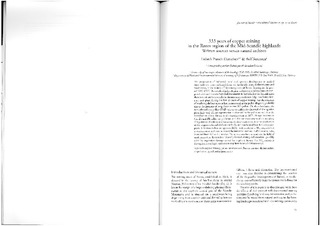| dc.contributor.author | Prøsch-Danielsen, Lisbeth | |
| dc.contributor.author | Sørensen, Rolf | |
| dc.date.accessioned | 2012-11-28T09:36:51Z | |
| dc.date.available | 2012-11-28T09:36:51Z | |
| dc.date.issued | 2010 | |
| dc.identifier.citation | Prøsch-Danielsen, L. og Sørensen, R. (2010). 333 years of copper mining in the Røros region of the Mid-Scandic highlands - written sources versus natural archives. Journal of Nordic Archaeological Science, 17, 37-51 | no_NO |
| dc.identifier.issn | 1650-1519 | |
| dc.identifier.uri | http://hdl.handle.net/11250/181521 | |
| dc.description.abstract | The progression of industrial, rural and agrarian development is studied from sediment cores collected from two kettlehole lakes, Doktortjønna and Sandtjønna, in the vicinity of the mining town of Røros, focusing on the period 1645-1977. The results of palynological and geochemical analyses are compared with well-known historical documents to test whether the records from these natural archives match the documentary evidences. Vigorous forest clearance took place during the first 25 years of copper mining, but the evidence of escalating deforestation is less pronounced in the pollen diagram, probably due to the presence of londgistance tree (AP) pollen. On the other hand, the non-arboreal tree pollen (NAP) curves do reflect the dispersal of the agrarian plots fairly well. Forest regeneration is observed in the pollen record after the introduction of coal for use in the roasting ovens in 1877. Abrupt increases in Cu, Zn and Pb reflect air pollution and the commencement of ore roasting. The presence of cations and variations in their content mirrors the production of the copperworks and shifts in methods, and can be used here for dating purposes. A decrease in loss-on-ignition (LOl), with a delay of c.50 years, serves as an indication of soil erosion caused by intensive land use. Sedimentation rates increased from 0.2 to 1.2 mm/yr. The source area for the sand was the field of sand-dunes (the Kvitsanden "desert") formed during deforestation, possibly
aided by vegetation damage caused by sulphuric fumes. The SO2 emissions
during periods of high production may have been >5 000 tonnes/yr. | no_NO |
| dc.language.iso | eng | no_NO |
| dc.publisher | Stockholm : Stockholms universitet | no_NO |
| dc.subject | arkeologi | no_NO |
| dc.subject | Røros | no_NO |
| dc.subject | Norge | no_NO |
| dc.subject | kobbergruver | no_NO |
| dc.subject | kobberutvinning | no_NO |
| dc.subject | avskoging | no_NO |
| dc.subject | copper mining | no_NO |
| dc.subject | deforestation | no_NO |
| dc.title | 333 years of copper mining in the Røros region of the Mid-Scandic highlands - written sources versus natural archives | no_NO |
| dc.type | Journal article | no_NO |
| dc.type | Peer reviewed | no_NO |
| dc.subject.nsi | VDP::Humanities: 000::Archeology: 090::Nordic archeology: 091 | no_NO |
| dc.source.pagenumber | 37-51 | no_NO |
| dc.source.volume | 17 | no_NO |
| dc.source.journal | Journal of Nordic Archaeological Science | no_NO |
